Long-Term Persistence in Observed Temperature and Precipitation Series
Abstract
1. Introduction
2. Data and Methods
2.1. Meteorological Data and Regions Analyzed
2.2. Estimation of the Hurst Exponent
2.3. Regional Averaging Considering Different Grid Cell Sizes
2.4. Analysis of CDM Plots
2.5. Regression Analysis Identifying Relative Subarea Contributions
2.6. Granger Causality Tests and Multifractal Detrended Cross-Correlation Analyses
3. Results
3.1. Hurst Exponents of the Gridded and Station ATP and AMT Series
3.2. Spatial Scale Dependence of the Strength of the Hurst Phenomenon
3.3. CDMs of ATP and AMT Averaged at Different Spatial Scales
3.4. Similarities in the CDMs of AMT and ATP Averaged at Different Spatial Scales
4. Discussion
4.1. Factors Affecting the Hurst Exponents of the Regionally Averaged ATP and AMT Series
4.2. Possible Causes of Hurst Phenomenon
4.3. Hurst Exponent Estimations and Data Limitation
5. Conclusions
- Across various spatial scales globally, the H values of AMT are generally higher than those of ATP, particularly with larger spatial scales of averaging. This finding is consistently validated using both gridded data covering all the land surfaces of the globe and 45 individual ground station datasets.
- Similarly to ATP, the H values of AMT also increase with the spatial scale of averaging. For all continents, the H values for continentally averaged ATP and AMT series are significantly higher than the median of the H values of grid-scale ATP and AMT series. In the 44 subregions defined by the IPCC-AR6, the H values of the regionally averaged ATP series exceed their grid-scale median H values in 29 of the subregions, while the H values of the regionally averaged AMT series exceed their respective grid-scale median H values in 32 of the subregions.
- The CDM time series of regionally averaged AMT follow a similar fluctuation pattern across all areas, but the CDM time series of regionally averaged ATP series do not follow a similar pattern. The difference in the CDM fluctuation patterns of regionally averaged ATP series contributed to the low H values of some continents and larger areas.
- In 12 of the 44 subregions analyzed, the CDMs of regionally averaged ATP fluctuate very similarly to the way the CDMs of the same regionally averaged AMT fluctuate. At 12 of the 45 ground monitoring stations, the CDMs of the ATP also fluctuate very similarly with the way the CDMs of AMT fluctuate. These similarities are observed throughout the observation period of 1901 to 2023 (see Figure 13 and Figure 14). Moreover, Granger causality tests showed that AMT is the Granger cause of ATP in 9 out of the 12 IPCC-AR6 subregions and 7 out of the 12 meteorological stations where similarities of CDM fluctuations in AMT and ATP were observed. The MF-DCCA analysis results reveal that for all regions at both global and continental scales, the ATP and AMT series are power-law cross-correlated. These findings suggest that the LTP of AMT and ATP are interrelated, implying that the Hurst phenomenon observed in AMT may be a potential driver of the Hurst phenomenon in ATP, or alternatively, that both may stem from a common underlying cause. More in-depth research may be conducted to verify further this new and insightful hypothesis.
Supplementary Materials
Author Contributions
Funding
Data Availability Statement
Acknowledgments
Conflicts of Interest
References
- Hurst, H.E. Methods of Using Long-Term Storage in Reservoirs. Proc. Inst. Civ. Eng. 1956, 5, 519–543. [Google Scholar] [CrossRef]
- Hurst, H.E. Long-Term Storage Capacity of Reservoirs. Trans. Am. Soc. Civ. Eng. 1951, 116, 770–799. [Google Scholar] [CrossRef]
- Salas, J.D.; Boes, D.C.; Yevjevich, V.; Pegram, G.G.S. Hurst Phenomenon as a Pre-Asymptotic Behavior. J. Hydrol. 1979, 44, 1–15. [Google Scholar] [CrossRef]
- Koutsoyiannis, D. Climate Change, the Hurst Phenomenon, and Hydrological Statistics. Hydrol. Sci. J. 2003, 48, 3–24. [Google Scholar] [CrossRef]
- O’Connell, P.E.; Koutsoyiannis, D.; Lins, H.F.; Markonis, Y.; Montanari, A.; Cohn, T. The Scientific Legacy of Harold Edwin Hurst (1880–1978). Hydrol. Sci. J. 2016, 61, 1571–1590. [Google Scholar] [CrossRef]
- O’Connell, E.; O’Donnell, G.; Koutsoyiannis, D. On the Spatial Scale Dependence of Long-Term Persistence in Global Annual Precipitation Data and the Hurst Phenomenon. Water Resour. Res. 2023, 59, e2022WR033133. [Google Scholar] [CrossRef]
- Villa, D.L.; Schostek, T.; Govertsen, K.; Macmillan, M. A Stochastic Model of Future Extreme Temperature Events for Infrastructure Analysis. Environ. Model. Softw. 2023, 163, 105663. [Google Scholar] [CrossRef]
- Koutsoyiannis, D.; Dimitriadis, P.; Lombardo, F.; Stevens, S. From Fractals to Stochastics: Seeking Theoretical Consistency in Analysis of Geophysical Data. In Advances in Nonlinear Geosciences; Tsonis, A.A., Ed.; Springer International Publishing: Cham, Switzerland, 2018; pp. 237–278. ISBN 978-3-319-58895-7. [Google Scholar]
- Fullhart, A.; Goodrich, D.C.; Meles, M.B.; Oliveira, P.T.S.; Almeida, C.d.N.; de Araújo, J.C.; Burns, S. Atlas of Precipitation Extremes for South America and Africa Based on Depth-Duration-Frequency Relationships in a Stochastic Weather Generator Dataset. Int. Soil Water Conserv. Res. 2023, 11, 726–742. [Google Scholar] [CrossRef]
- Pizarro, A.; Acuña, P.; Dimitriadis, P.; Iliopoulou, T.; Koutsoyiannis, D. Past, Present, and Future of the Hurst-Kolmogorov Dynamics in Stochastics: A Bibliometric Analysis of the Last 50 Years in Water Resources. J. Hydrol. 2024, 643, 132008. [Google Scholar] [CrossRef]
- Koutsoyiannis, D.; Iliopoulou, T.; Koukouvinos, A.; Malamos, N.; Mamassis, N.; Dimitriadis, P.; Tepetidis, N.; Markantonis, D. In Search of Climate Crisis in Greece Using Hydrological Data: 404 Not Found. Water 2023, 15, 1711. [Google Scholar] [CrossRef]
- O’Connell, E.; O’Donnell, G.; Koutsoyiannis, D. The Spatial Scale Dependence of The Hurst Coefficient in Global Annual Precipitation Data, and Its Role in Characterising Regional Precipitation Deficits within a Naturally Changing Climate. Hydrology 2022, 9, 199. [Google Scholar] [CrossRef]
- Iliopoulou, T.; Papalexiou, S.M.; Markonis, Y.; Koutsoyiannis, D. Revisiting Long-Range Dependence in Annual Precipitation. J. Hydrol. 2018, 556, 891–900. [Google Scholar] [CrossRef]
- Tyralis, H.; Dimitriadis, P.; Koutsoyiannis, D.; O’Connell, P.E.; Tzouka, K.; Iliopoulou, T. On the Long-Range Dependence Properties of Annual Precipitation Using a Global Network of Instrumental Measurements. Adv. Water Resour. 2018, 111, 301–318. [Google Scholar] [CrossRef]
- Szolgayova, E.; Laaha, G.; Blöschl, G.; Bucher, C. Factors Influencing Long Range Dependence in Streamflow of European Rivers. Hydrol. Process. 2014, 28, 1573–1586. [Google Scholar] [CrossRef]
- Bracken, C.; Rajagopalan, B.; Zagona, E. A Hidden Markov Model Combined with Climate Indices for Multidecadal Streamflow Simulation. Water Resour. Res. 2014, 50, 7836–7846. [Google Scholar] [CrossRef]
- Chaves, H.M.L.; Lorena, D.R. Assessing Reservoir Reliability Using Classical and Long-Memory Statistics. J. Hydrol. Reg. Stud. 2019, 26, 100641. [Google Scholar] [CrossRef]
- Glynis, K.-G.; Iliopoulou, T.; Dimitriadis, P.; Koutsoyiannis, D. Stochastic Investigation of Daily Air Temperature Extremes from a Global Ground Station Network. Stoch. Environ. Res. Risk Assess. 2021, 35, 1585–1603. [Google Scholar] [CrossRef]
- Hamed, K.H. Improved Finite-Sample Hurst Exponent Estimates Using Rescaled Range Analysis. Water Resour. Res. 2007, 43, W04413. [Google Scholar] [CrossRef]
- Katikas, L.; Dimitriadis, P.; Koutsoyiannis, D.; Kontos, T.; Kyriakidis, P. A Stochastic Simulation Scheme for the Long-Term Persistence, Heavy-Tailed and Double Periodic Behavior of Observational and Reanalysis Wind Time-Series. Appl. Energy 2021, 295, 116873. [Google Scholar] [CrossRef]
- Bakker, A.M.R.; van den Hurk, B.J.J.M. Estimation of Persistence and Trends in Geostrophic Wind Speed for the Assessment of Wind Energy Yields in Northwest Europe. Clim. Dyn. 2012, 39, 767–782. [Google Scholar] [CrossRef]
- Lu, C.; Song, Z.; Wang, W.; Zhang, Y.; Si, H.; Liu, B.; Shu, L. Spatiotemporal Variation and Long-Range Correlation of Groundwater Depth in the Northeast China Plain and North China Plain from 2000∼2019. J. Hydrol. Reg. Stud. 2021, 37, 100888. [Google Scholar] [CrossRef]
- Dimitriadis, P.; Tegos, A.; Koutsoyiannis, D. Stochastic Analysis of Hourly to Monthly Potential Evapotranspiration with a Focus on the Long-Range Dependence and Application with Reanalysis and Ground-Station Data. Hydrology 2021, 8, 177. [Google Scholar] [CrossRef]
- Plocoste, T.; Pavón-Domínguez, P. Multifractal Detrended Cross-Correlation Analysis of Wind Speed and Solar Radiation. Chaos Interdiscip. J. Nonlinear Sci. 2020, 30, 113109. [Google Scholar] [CrossRef]
- Liu, J.; Cheng, C.; Yang, X.; Yan, L.; Lai, Y. Analysis of the Efficiency of Hong Kong REITs Market Based on Hurst Exponent. Phys. A Stat. Mech. Its Appl. 2019, 534, 122035. [Google Scholar] [CrossRef]
- Bui, Q.; Ślepaczuk, R. Applying Hurst Exponent in Pair Trading Strategies on Nasdaq 100 Index. Phys. A Stat. Mech. Its Appl. 2022, 592, 126784. [Google Scholar] [CrossRef]
- Wei, M.; Qin, J.; Yan, R.; Li, H.; Yao, Z.; Lu, Q. Identifying Major Depressive Disorder Using Hurst Exponent of Resting-State Brain Networks. Psychiatry Res. Neuroimaging 2013, 214, 306–312. [Google Scholar] [CrossRef] [PubMed]
- Wang, Y.-Z.; Li, B.; Wang, R.-Q.; Su, J.; Rong, X.-X. Application of the Hurst Exponent in Ecology. Comput. Math. Appl. 2011, 61, 2129–2131. [Google Scholar] [CrossRef]
- Zhao, N.; Yue, T.; Li, H.; Zhang, L.; Yin, X.; Liu, Y. Spatio-Temporal Changes in Precipitation over Beijing-Tianjin-Hebei Region, China. Atmos. Res. 2018, 202, 156–168. [Google Scholar] [CrossRef]
- Lu, C.; Ma, L.; Liu, T.; Huang, X.; Sun, G. Quantitative Response Relationships between Annual Precipitation in China from 1951 to 2018 and Its Influencing Factors. Hydrol. Res. 2022, 53, 766–781. [Google Scholar] [CrossRef]
- Cheng, R.; Novak, L.; Schneider, T. Predicting the Interannual Variability of California’s Total Annual Precipitation. Geophys. Res. Lett. 2021, 48, e2020GL091465. [Google Scholar] [CrossRef]
- Lana, X.; Casas-Castillo, M.C.; Rodríguez-Solà, R.; Prohom, M.; Serra, C.; Martínez, M.D.; Kirchner, R. Time Trends, Irregularity and Multifractal Structure on the Monthly Rainfall Regime at Barcelona, NE Spain, Years 1786–2019. Int. J. Climatol. 2023, 43, 499–518. [Google Scholar] [CrossRef]
- Oñate Rubalcaba, J.J. Fractal Analysis of Climatic Data: Annual Precipitation Records in Spain. Theor. Appl. Climatol. 1997, 56, 83–87. [Google Scholar] [CrossRef]
- Markovic, D.; Koch, M. Wavelet and Scaling Analysis of Monthly Precipitation Extremes in Germany in the 20th Century: Interannual to Interdecadal Oscillations and the North Atlantic Oscillation Influence. Water Resour. Res. 2005, 41, W09420. [Google Scholar] [CrossRef]
- Bunde, A.; Büntgen, U.; Ludescher, J.; Luterbacher, J.; von Storch, H. Is There Memory in Precipitation? Nat. Clim. Change 2013, 3, 174–175. [Google Scholar] [CrossRef]
- He, Y.; Mu, X.; Gao, P.; Zhao, G.; Wang, F.; Sun, W.; Zhang, Y. Spatial Variability and Periodicity of Precipitation in the Middle Reaches of the Yellow River, China. Adv. Meteorol. 2016, 2016, 9451614. [Google Scholar] [CrossRef]
- Shi, P.; Wu, M.; Qu, S.; Jiang, P.; Qiao, X.; Chen, X.; Zhou, M.; Zhang, Z. Spatial Distribution and Temporal Trends in Precipitation Concentration Indices for the Southwest China. Water Resour. Manag. 2015, 29, 3941–3955. [Google Scholar] [CrossRef]
- Fatichi, S.; Ivanov, V.Y.; Caporali, E. Investigating Interannual Variability of Precipitation at the Global Scale: Is There a Connection with Seasonality? J. Clim. 2012, 25, 5512–5523. [Google Scholar] [CrossRef]
- Poveda, G. Mixed Memory, (Non) Hurst Effect, and Maximum Entropy of Rainfall in the Tropical Andes. Adv. Water Resour. 2011, 34, 243–256. [Google Scholar] [CrossRef]
- Valle, M.A.V.; García, G.M.; Cohen, I.S.; Oleschko, L.K.; Corral, J.A.R.; Korvin, G. Spatial Variability of the Hurst Exponent for the Daily Scale Rainfall Series in the State of Zacatecas, Mexico. J. Appl. Meteorol. Climatol. 2013, 52, 2771–2780. [Google Scholar] [CrossRef]
- Markonis, Y.; Koutsoyiannis, D. Scale-Dependence of Persistence in Precipitation Records. Nat. Clim. Change 2016, 6, 399–401. [Google Scholar] [CrossRef]
- Galiano, L.; Monjo, R.; Royé, D.; Martin-Vide, J. Will the World Experience More Fractal Droughts? Atmos. Res. 2025, 316, 107941. [Google Scholar] [CrossRef]
- Liu, Y.; Zhang, K.; Zhang, W.; Shao, Y.; Pei, H.; Feng, J. Multifractal Analysis of 1-Min Summer Rainfall Time Series from a Monsoonal Watershed in Eastern China. Theor. Appl. Climatol. 2013, 111, 37–50. [Google Scholar] [CrossRef]
- Svensson, C.; Olsson, J.; Berndtsson, R. Multifractal Properties of Daily Rainfall in Two Different Climates. Water Resour. Res. 1996, 32, 2463–2472. [Google Scholar] [CrossRef]
- de Lima, M.I.P. A Fractal and Multifractal Study of Hourly Precipitation Time-Series from The Netherlands. In Hydrologic Modeling; Singh, V.P., Soe, W.I., Sonu, J.H., Eds.; Water Resources Publications: Littleton, CO, USA, 1999; pp. 15–28. [Google Scholar]
- Monjo, R.; Meseguer-Ruiz, O. Review: Fractal Geometry in Precipitation. Atmosphere 2024, 15, 135. [Google Scholar] [CrossRef]
- Carmen Casas, M.; Herrero, M.; Ninyerola, M.; Pons, X.; Rodríguez, R.; Rius, A.; Redaño, A. Analysis and Objective Mapping of Extreme Daily Rainfall in Catalonia. Int. J. Climatol. 2007, 27, 399–409. [Google Scholar] [CrossRef]
- Monjo, R.; Royé, D.; Martin-Vide, J. Meteorological Drought Lacunarity around the World and Its Classification. Earth Syst. Sci. Data 2020, 12, 741–752. [Google Scholar] [CrossRef]
- Medina-Cobo, M.T.; García-Marín, A.P.; Estévez, J.; Jiménez-Hornero, F.J.; Ayuso-Muñoz, J.L. Obtaining Homogeneous Regions by Determining the Generalized Fractal Dimensions of Validated Daily Rainfall Data Sets. Water Resour Manag. 2017, 31, 2333–2348. [Google Scholar] [CrossRef]
- Xu, X.-L.; Li, G.-D.; Dai, W.-Y.; Song, X.-M. Multi-Direction Chain and Grid Chaotic System Based on Julia Fractal. Fractals 2021, 29, 2150245. [Google Scholar] [CrossRef]
- Xiao, L.-Q.; Duan, S.-K.; Wang, L.-D. Julia fractal based multi-scroll memristive chaotic system. Acta Phys. Sin. 2018, 67, 090502. [Google Scholar] [CrossRef]
- Yan, D.; Wang, L.; Duan, S.; Chen, J.; Chen, J. Chaotic Attractors Generated by a Memristor-Based Chaotic System and Julia Fractal. Chaos Solitons Fractals 2021, 146, 110773. [Google Scholar] [CrossRef]
- Zhou, J.; Li, P.; Wang, J. Effects of Light Intensity and Temperature on the Photosynthesis Characteristics and Yield of Lettuce. Horticulturae 2022, 8, 178. [Google Scholar] [CrossRef]
- Zheng, Z.; Hoogenboom, G.; Cai, H.; Wang, Z. Winter Wheat Production on the Guanzhong Plain of Northwest China under Projected Future Climate with SimCLIM. Agric. Water Manag. 2020, 239, 106233. [Google Scholar] [CrossRef]
- Sun, L.; Zheng, X.; Zhang, P.; Cai, J.; Bai, J. Research on the Correlation between Three-Dimensional Morphology and Temperature Changes in Potato Slices during Drying. Curr. Res. Food Sci. 2023, 6, 100524. [Google Scholar] [CrossRef]
- Chauhdary, J.N.; Li, H.; Akbar, N.; Javaid, M.; Rizwan, M.; Akhlaq, M. Evaluating Corn Production under Different Plant Spacings through Integrated Modeling Approach and Simulating Its Future Response under Climate Change Scenarios. Agric. Water Manag. 2024, 293, 108691. [Google Scholar] [CrossRef]
- He, W.; Liu, Y.; Sun, H.; Taghizadeh-Hesary, F. How Does Climate Change Affect Rice Yield in China? Agriculture 2020, 10, 441. [Google Scholar] [CrossRef]
- Peters, G.P.; Andrew, R.M.; Boden, T.; Canadell, J.G.; Ciais, P.; Le Quéré, C.; Marland, G.; Raupach, M.R.; Wilson, C. The Challenge to Keep Global Warming below 2 °C. Nat. Clim. Change 2013, 3, 4–6. [Google Scholar] [CrossRef]
- Schleussner, C.-F.; Ganti, G.; Lejeune, Q.; Zhu, B.; Pfleiderer, P.; Prütz, R.; Ciais, P.; Frölicher, T.L.; Fuss, S.; Gasser, T.; et al. Overconfidence in Climate Overshoot. Nature 2024, 634, 366–373. [Google Scholar] [CrossRef]
- Tollefson, J. Severe Weather Linked More Strongly to Global Warming. Nature 2015. [Google Scholar] [CrossRef]
- Brown, P.T.; Hanley, H.; Mahesh, A.; Reed, C.; Strenfel, S.J.; Davis, S.J.; Kochanski, A.K.; Clements, C.B. Climate Warming Increases Extreme Daily Wildfire Growth Risk in California. Nature 2023, 621, 760–766. [Google Scholar] [CrossRef]
- Jevrejeva, S.; Jackson, L.P.; Riva, R.E.M.; Grinsted, A.; Moore, J.C. Coastal Sea Level Rise with Warming above 2 °C. Proc. Natl. Acad. Sci. USA 2016, 113, 13342–13347. [Google Scholar] [CrossRef]
- Wu, P.; Liu, Y.-J.; Wang, J.; Ding, Y.-H. Revisiting the Variations of Precipitation and Water Vapour Budget over the Tibetan Plateau. Adv. Clim. Change Res. 2023, 14, 77–84. [Google Scholar] [CrossRef]
- Deng, H.; Wang, Q.; Zhao, Y.; Zhai, J.; Zhu, Y.; Gui, Y.; Wang, L.; Song, T.; Chen, X.; Liu, K. Effect of Water Vapor Transport and Budget on Precipitation in the Yangtze–Huang–Huai–Hai River Basin. J. Hydrol. Reg. Stud. 2024, 53, 101787. [Google Scholar] [CrossRef]
- Adeliyi, T.E.; Akinsanola, A.A. Recent Trends and Variability of Temperature and Atmospheric Water Vapor over South Asia. Atmos. Res. 2024, 309, 107556. [Google Scholar] [CrossRef]
- Allan, R.P.; Liepert, B.G. Anticipated Changes in the Global Atmospheric Water Cycle. Environ. Res. Lett. 2010, 5, 025201. [Google Scholar] [CrossRef]
- Wasko, C.; Nathan, R. The Local Dependency of Precipitation on Historical Changes in Temperature. Clim. Change 2019, 156, 105–120. [Google Scholar] [CrossRef]
- Szolgayova, E.; Parajka, J.; Blöschl, G.; Bucher, C. Long Term Variability of the Danube River Flow and Its Relation to Precipitation and Air Temperature. J. Hydrol. 2014, 519, 871–880. [Google Scholar] [CrossRef]
- Yin, J.; Gentine, P.; Zhou, S.; Sullivan, S.C.; Wang, R.; Zhang, Y.; Guo, S. Large Increase in Global Storm Runoff Extremes Driven by Climate and Anthropogenic Changes. Nat. Commun. 2018, 9, 4389. [Google Scholar] [CrossRef]
- Gu, L.; Yin, J.; Gentine, P.; Wang, H.-M.; Slater, L.J.; Sullivan, S.C.; Chen, J.; Zscheischler, J.; Guo, S. Large Anomalies in Future Extreme Precipitation Sensitivity Driven by Atmospheric Dynamics. Nat. Commun. 2023, 14, 3197. [Google Scholar] [CrossRef]
- O’Gorman, P.A.; Schneider, T. The Physical Basis for Increases in Precipitation Extremes in Simulations of 21st-Century Climate Change. Proc. Natl. Acad. Sci. USA 2009, 106, 14773–14777. [Google Scholar] [CrossRef]
- Harris, I.; Osborn, T.J.; Jones, P.; Lister, D. Version 4 of the CRU TS Monthly High-Resolution Gridded Multivariate Climate Dataset. Sci. Data 2020, 7, 109. [Google Scholar] [CrossRef]
- Caccia, D.C.; Percival, D.; Cannon, M.J.; Raymond, G.; Bassingthwaighte, J.B. Analyzing Exact Fractal Time Series: Evaluating Dispersional Analysis and Rescaled Range Methods. Phys. A Stat. Mech. Its Appl. 1997, 246, 609–632. [Google Scholar] [CrossRef] [PubMed]
- Serinaldi, F. Use and Misuse of Some Hurst Parameter Estimators Applied to Stationary and Non-Stationary Financial Time Series. Phys. A Stat. Mech. Its Appl. 2010, 389, 2770–2781. [Google Scholar] [CrossRef]
- Roume, C.; Ezzina, S.; Blain, H.; Delignières, D. Biases in the Simulation and Analysis of Fractal Processes. Comput. Math. Methods Med. 2019, 2019, 4025305. [Google Scholar] [CrossRef]
- Roume, C. A Guide to Whittle Maximum Likelihood Estimator in MATLAB. Front. Netw. Physiol. 2023, 3, 1204757. [Google Scholar] [CrossRef]
- Qian, X.-Y.; Gu, G.-F.; Zhou, W.-X. Modified Detrended Fluctuation Analysis Based on Empirical Mode Decomposition for the Characterization of Anti-Persistent Processes. Phys. A Stat. Mech. Its Appl. 2011, 390, 4388–4395. [Google Scholar] [CrossRef][Green Version]
- Malamud, B.D.; Turcotte, D.L. Self-Affine Time Series: Measures of Weak and Strong Persistence. J. Stat. Plan. Inference 1999, 80, 173–196. [Google Scholar] [CrossRef]
- Markham, K.; Frazier, A.E.; Singh, K.K.; Madden, M. A Review of Methods for Scaling Remotely Sensed Data for Spatial Pattern Analysis. Landsc. Ecol. 2023, 38, 619–635. [Google Scholar] [CrossRef]
- Kelly, K.; Šavrič, B. Area and Volume Computation of Longitude–Latitude Grids and Three-Dimensional Meshes. Trans. GIS 2021, 25, 6–24. [Google Scholar] [CrossRef]
- Granger, C.W.J. Investigating Causal Relations by Econometric Models and Cross-Spectral Methods. Econometrica 1969, 37, 424–438. [Google Scholar] [CrossRef]
- Zhou, W.-X. Multifractal Detrended Cross-Correlation Analysis for Two Nonstationary Signals. Phys. Rev. E 2008, 77, 066211. [Google Scholar] [CrossRef]
- Zhang, C.; Ni, Z.; Ni, L. Multifractal Detrended Cross-Correlation Analysis between PM2.5 and Meteorological Factors. Phys. A Stat. Mech. Its Appl. 2015, 438, 114–123. [Google Scholar] [CrossRef]
- Hajian, S.; Movahed, M.S. Multifractal Detrended Cross-Correlation Analysis of Sunspot Numbers and River Flow Fluctuations. Phys. A Stat. Mech. Its Appl. 2010, 389, 4942–4957. [Google Scholar] [CrossRef]
- Koutsoyiannis, D.; Paschalis, A.; Theodoratos, N. Two-Dimensional Hurst–Kolmogorov Process and Its Application to Rainfall Fields. J. Hydrol. 2011, 398, 91–100. [Google Scholar] [CrossRef]
- Trenberth, K.E. Changes in Precipitation with Climate Change. Clim. Res. 2011, 47, 123–138. [Google Scholar] [CrossRef]
- Berg, P.; Moseley, C.; Haerter, J.O. Strong Increase in Convective Precipitation in Response to Higher Temperatures. Nat. Geosci. 2013, 6, 181–185. [Google Scholar] [CrossRef]
- Ban, N.; Schmidli, J.; Schaer, C. Heavy Precipitation in a Changing Climate: Does Short-Term Summer Precipitation Increase Faster? Geophys. Res. Lett. 2015, 42, 1165–1172. [Google Scholar] [CrossRef]
- Han, Z.; Su, T.; Huang, B.; Feng, T.; Qu, S.; Feng, G. Changes in Global Monsoon Precipitation and the Related Dynamic and Thermodynamic Mechanisms in Recent Decades. Int. J. Climatol. 2019, 39, 1490–1503. [Google Scholar] [CrossRef]
- Milrad, S.M.; Lombardo, K.; Atallah, E.H.; Gyakum, J.R. Numerical Simulations of the 2013 Alberta Flood: Dynamics, Thermodynamics, and the Role of Orography. Mon. Weather Rev. 2017, 145, 3049–3072. [Google Scholar] [CrossRef]
- Lorenz, R.; Argueeso, D.; Donat, M.G.; Pitman, A.J.; van den Hurk, B.; Berg, A.; Lawrence, D.M.; Cheruy, F.; Ducharne, A.; Hagemann, S.; et al. Influence of Land-Atmosphere Feedbacks on Temperature and Precipitation Extremes in the GLACE-CMIP5 Ensemble. J. Geophys. Res.-Atmos. 2016, 121, 607–623. [Google Scholar] [CrossRef]
- Zhao, W.; Chen, S.; An, X.; Wu, R.; Chen, W.; Zhang, F.; Zhang, Y.; Yang, L.; Song, L.; Wang, L. Mechanisms of Persistent Extreme Rainfall Event in North China, July 2023: Role of Atmospheric Diabatic Heating. J. Geophys. Res.-Atmos. 2025, 130, e2024JD042717. [Google Scholar] [CrossRef]
- Bevacqua, E.; Zappa, G.; Lehner, F.; Zscheischler, J. Precipitation Trends Determine Future Occurrences of Compound Hot–Dry Events. Nat. Clim. Chang. 2022, 12, 350–355. [Google Scholar] [CrossRef]
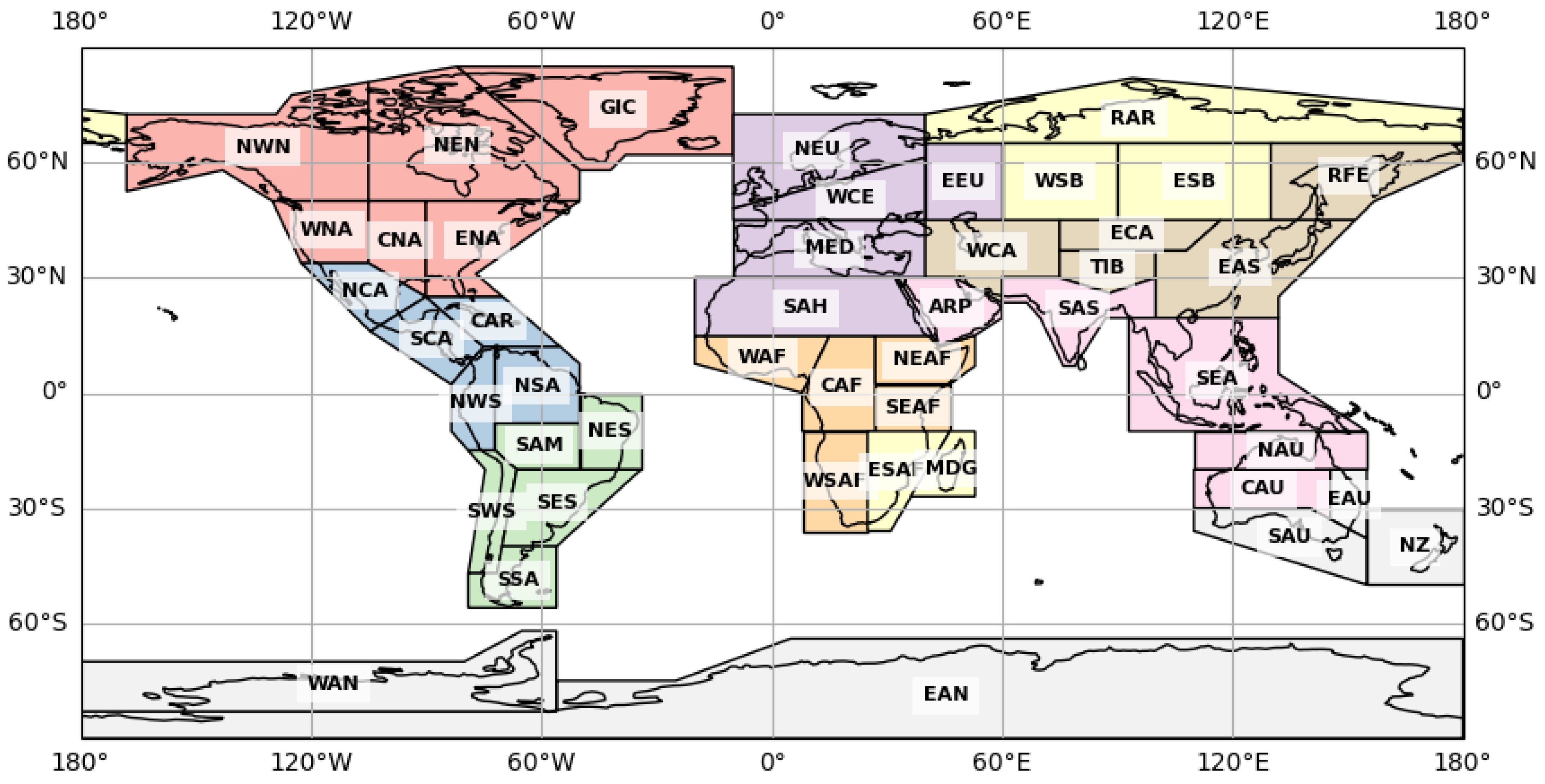
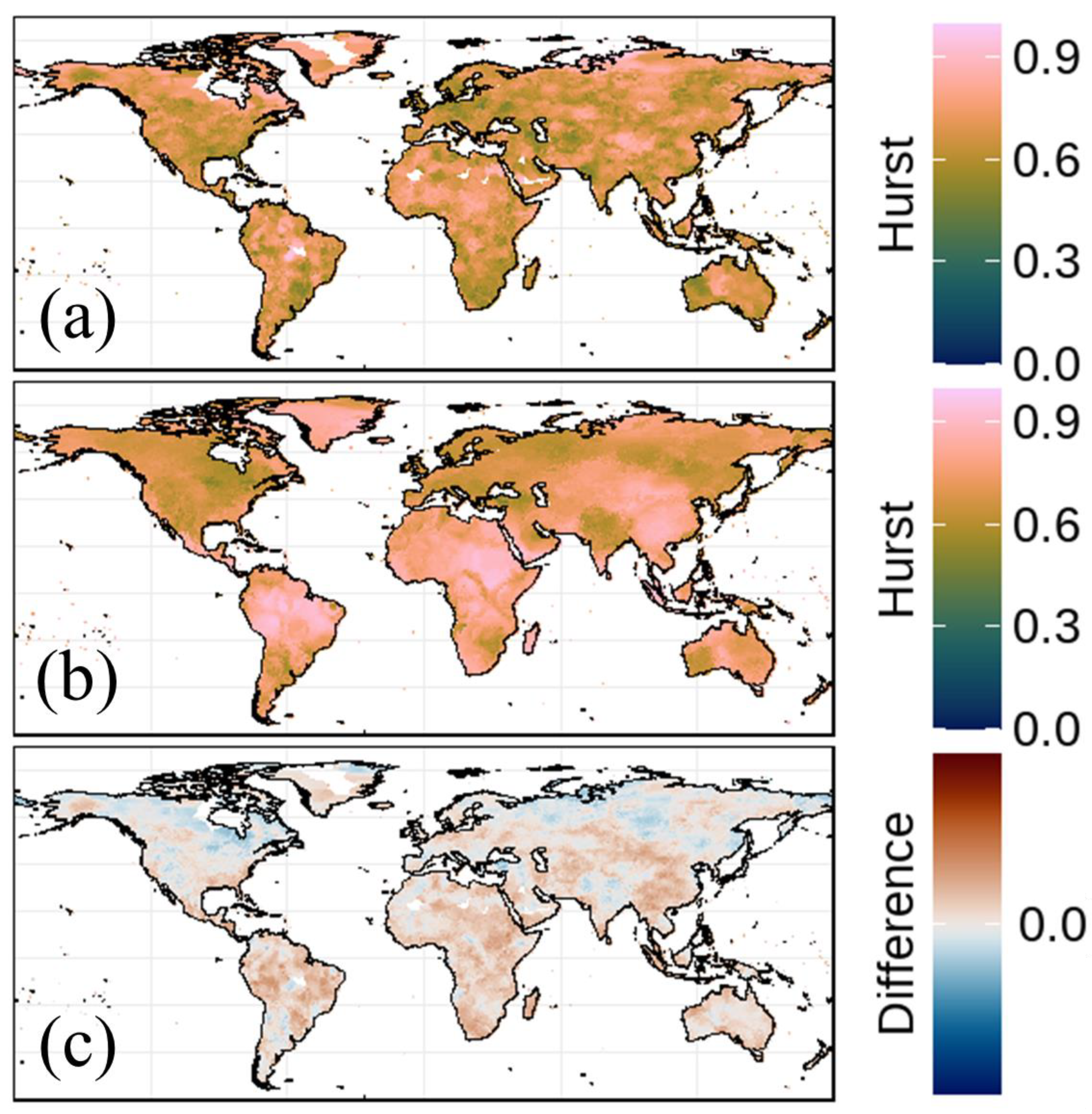


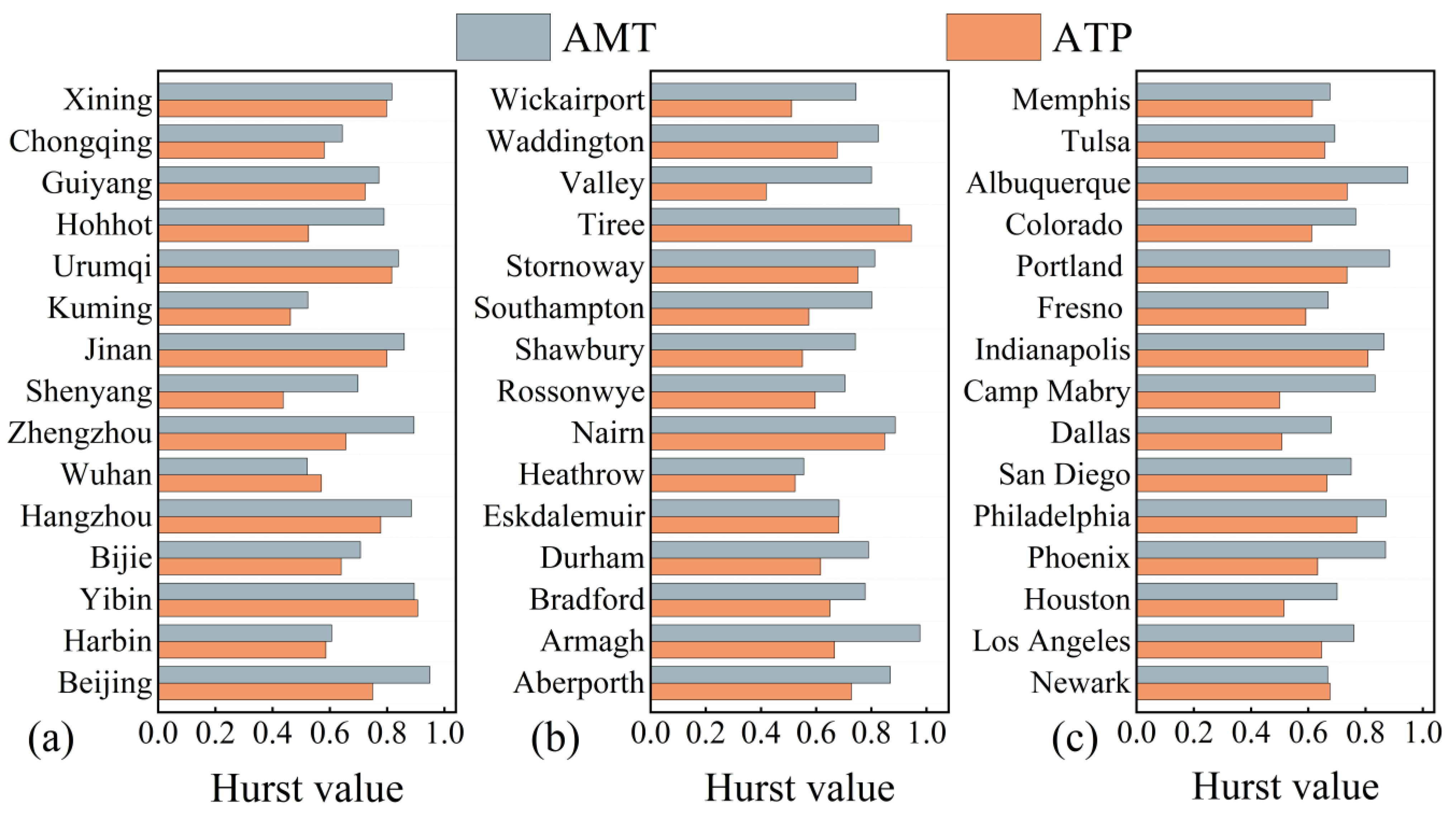
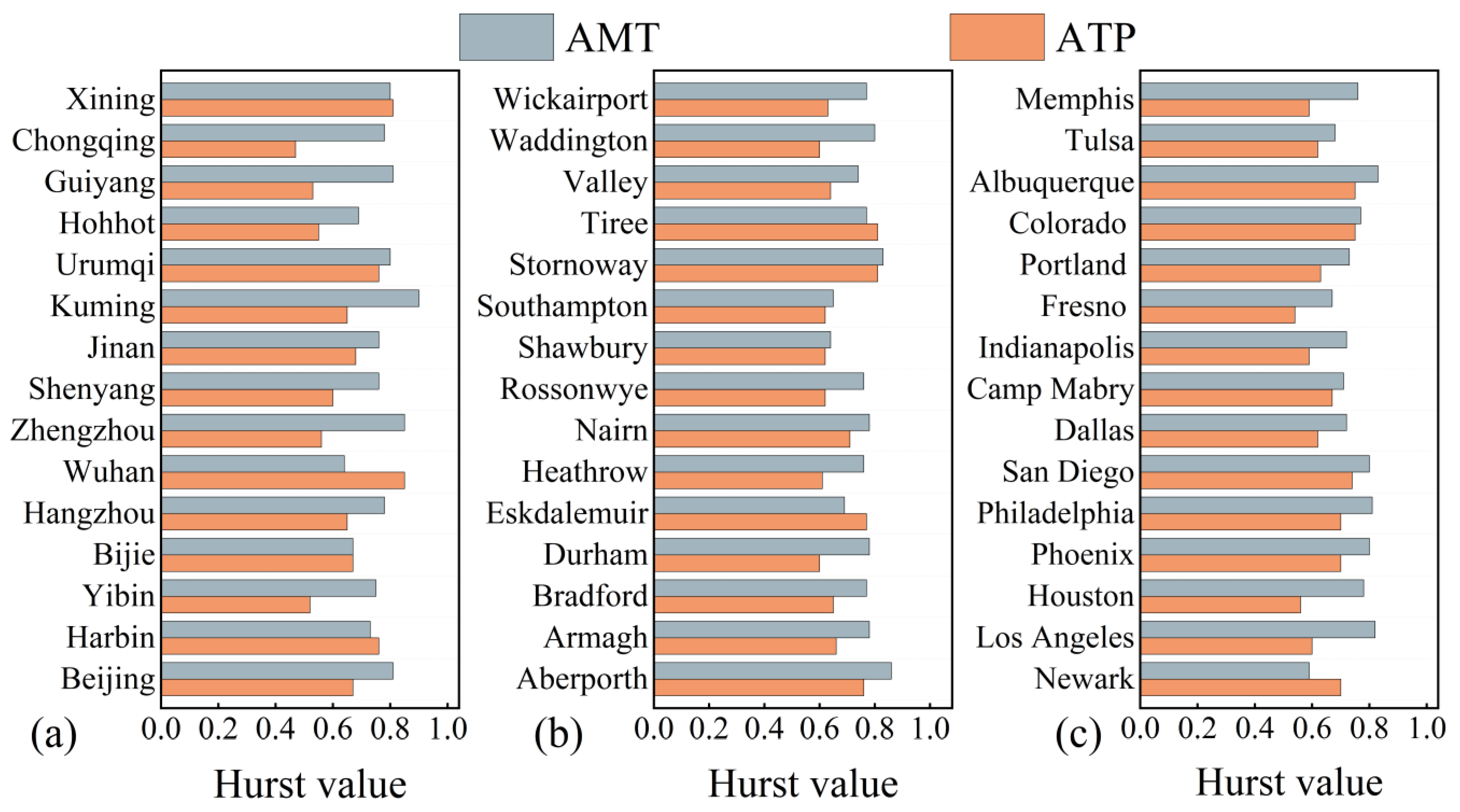
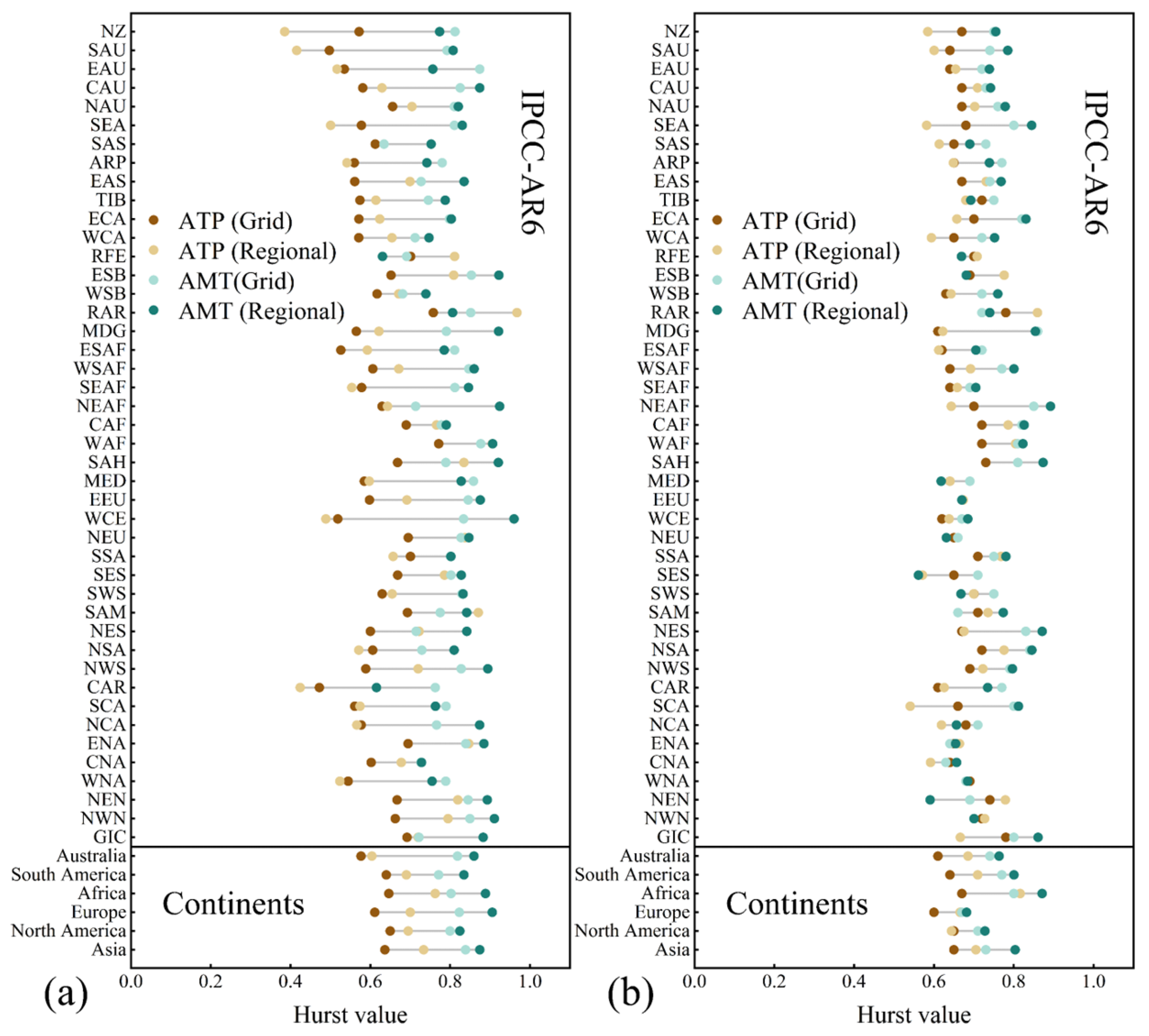
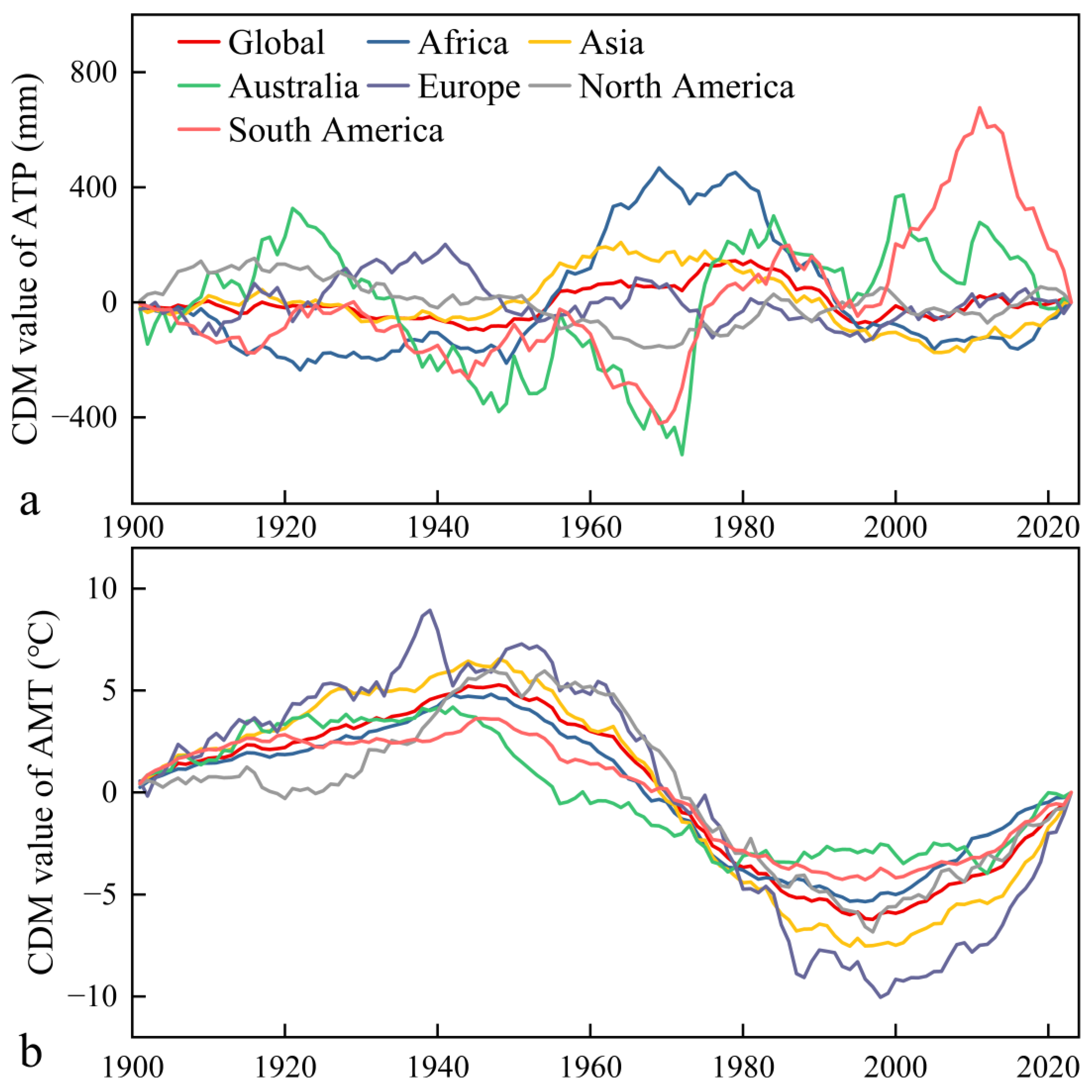
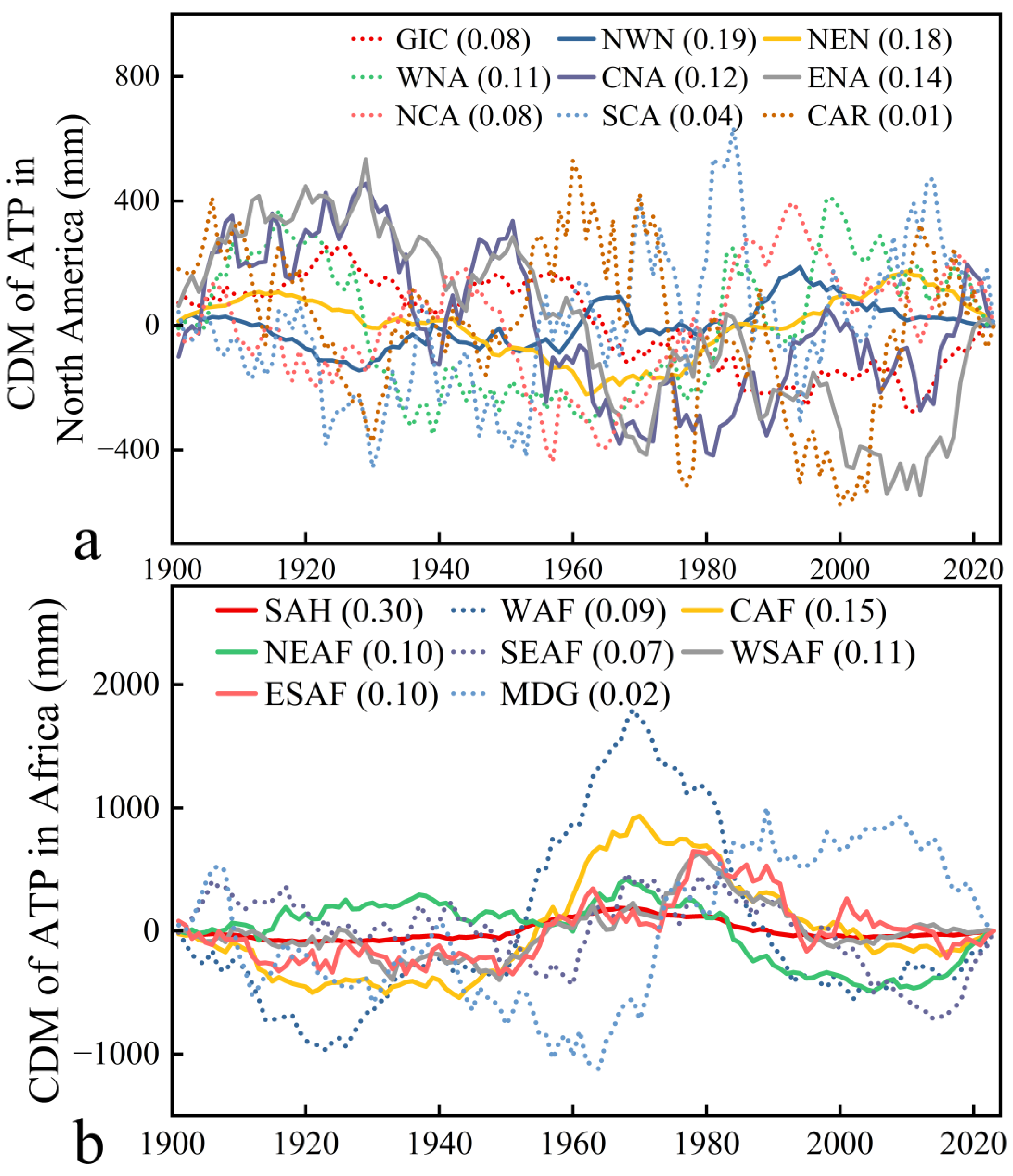
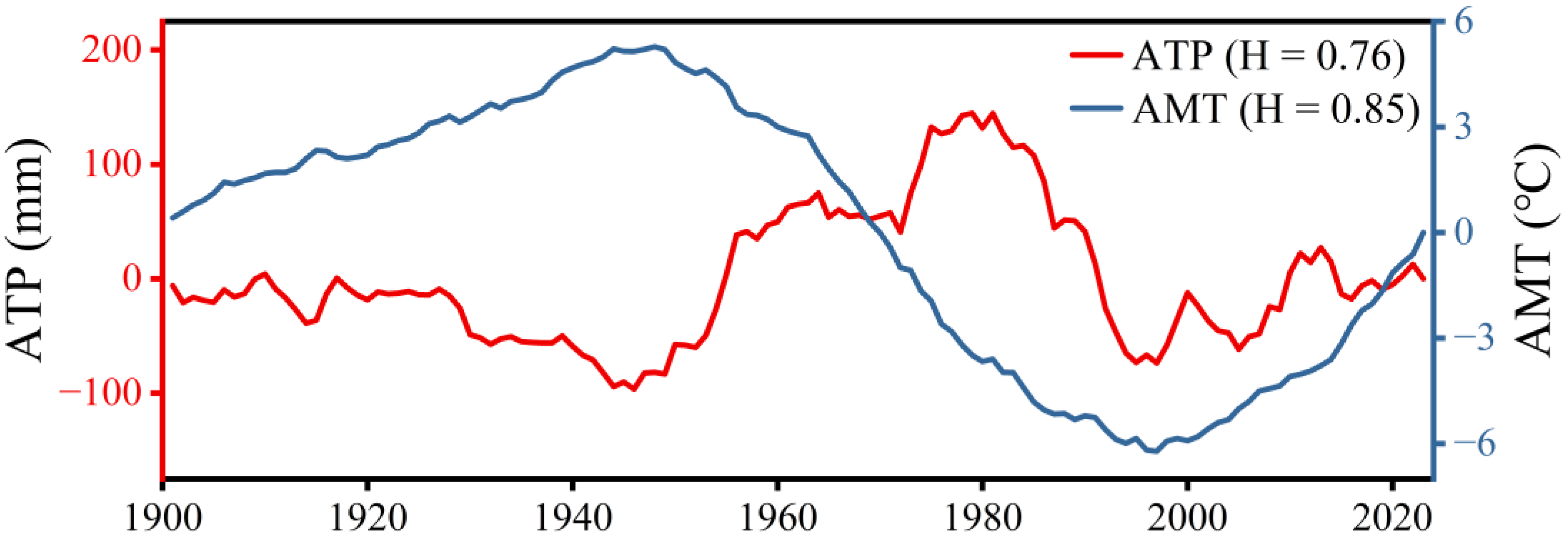
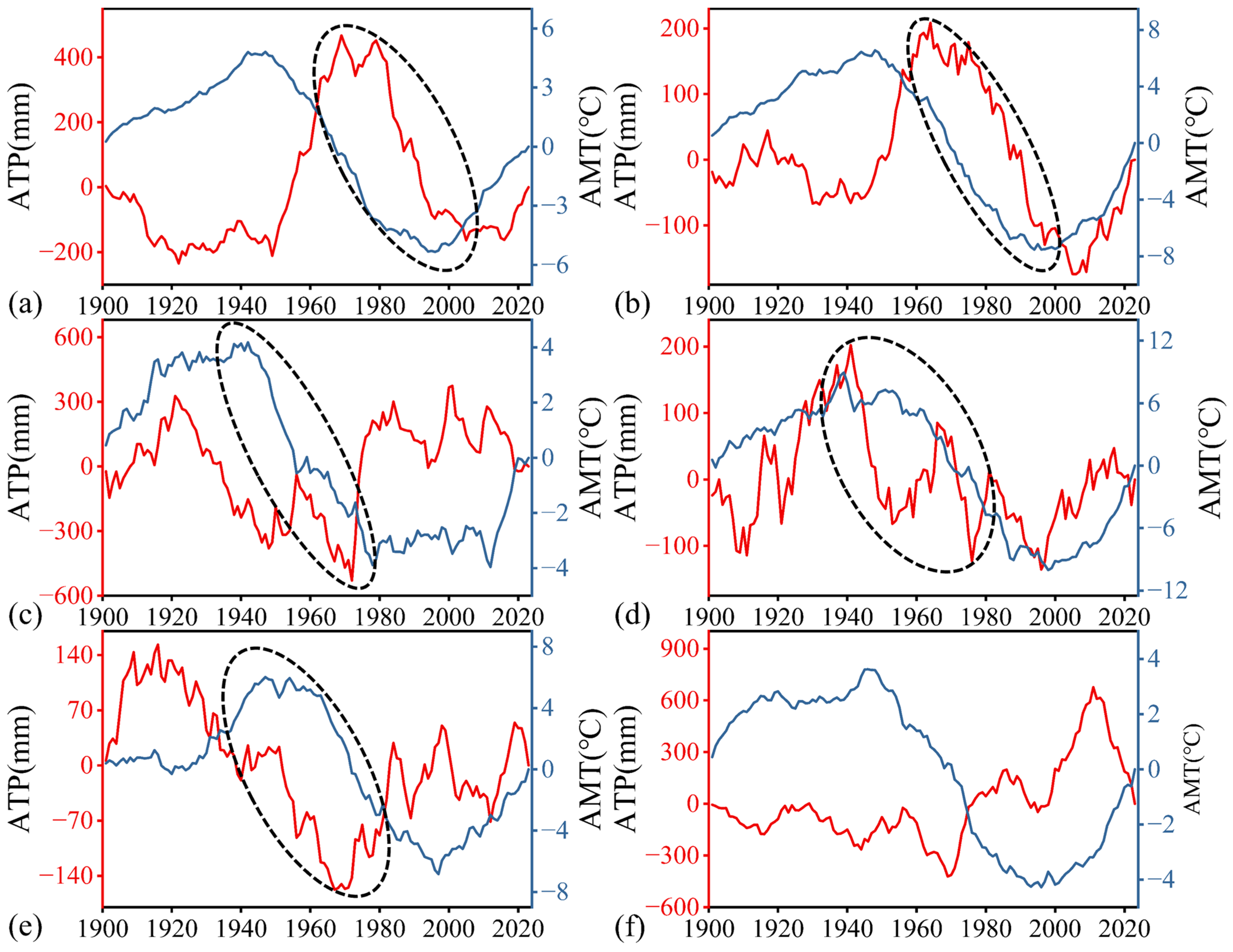
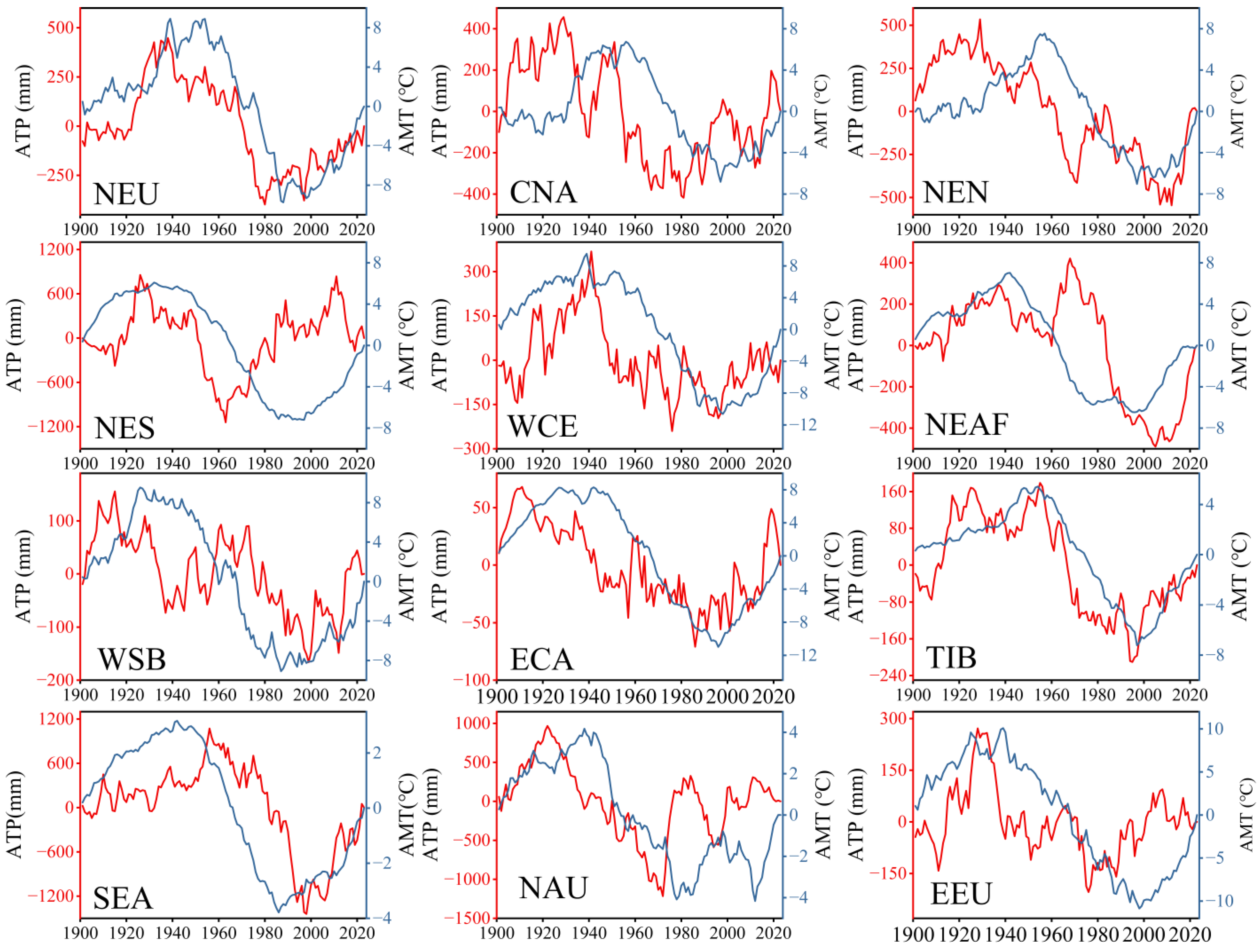


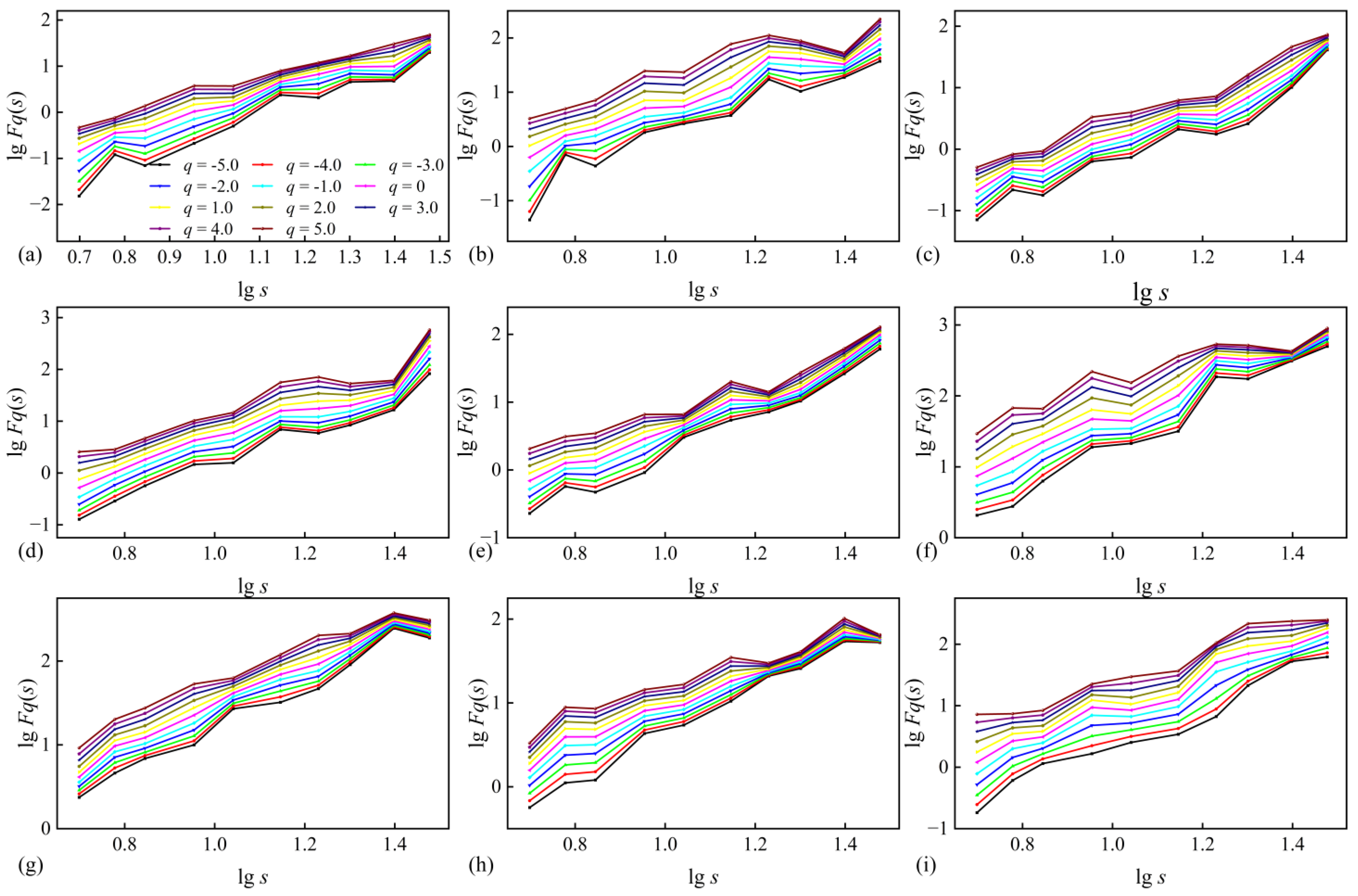

| Region | Lag Time | F Statistic | p-Value | Station | Lag Time | F Statistic | p-Value |
|---|---|---|---|---|---|---|---|
| NEU | 1 | 4.1118 | 0.0448 | Beijing | 3 | 2.1053 | 0.1105 |
| CNA | 1 | 0.5652 | 0.4537 | Harbin | 3 | 1.8382 | 0.1520 |
| NEN | 3 | 4.8648 | 0.0032 | Wuhan | 1 | 6.2990 | 0.0148 |
| NES | 2 | 23.6804 | 0.0001 | Hohhot | 4 | 4.9122 | 0.0021 |
| WCE | 2 | 8.6978 | 0.0003 | Aberporth | 1 | 7.8899 | 0.0063 |
| NEAF | 2 | 8.3119 | 0.0004 | Eskdalemuir | 4 | 3.1738 | 0.0395 |
| WSB | 3 | 1.0103 | 0.3910 | Heathrow | 1 | 5.2413 | 0.0254 |
| ECA | 8 | 4.2472 | 0.0002 | Rossonwye | 4 | 2.1738 | 0.0795 |
| TIB | 6 | 3.4034 | 0.0042 | Los Angeles | 2 | 0.0703 | 0.9322 |
| SEA | 3 | 8.2080 | 0.0001 | Phoenix | 2 | 1.0216 | 0.3657 |
| NAU | 4 | 3.7286 | 0.0070 | Dallas | 8 | 2.2194 | 0.0323 |
| EEU | 1 | 2.9359 | 0.0892 | San Diego | 2 | 2.6638 | 0.0675 |
Disclaimer/Publisher’s Note: The statements, opinions and data contained in all publications are solely those of the individual author(s) and contributor(s) and not of MDPI and/or the editor(s). MDPI and/or the editor(s) disclaim responsibility for any injury to people or property resulting from any ideas, methods, instructions or products referred to in the content. |
© 2025 by the authors. Licensee MDPI, Basel, Switzerland. This article is an open access article distributed under the terms and conditions of the Creative Commons Attribution (CC BY) license (https://creativecommons.org/licenses/by/4.0/).
Share and Cite
Zhong, H.; Guo, Y. Long-Term Persistence in Observed Temperature and Precipitation Series. Fractal Fract. 2025, 9, 385. https://doi.org/10.3390/fractalfract9060385
Zhong H, Guo Y. Long-Term Persistence in Observed Temperature and Precipitation Series. Fractal and Fractional. 2025; 9(6):385. https://doi.org/10.3390/fractalfract9060385
Chicago/Turabian StyleZhong, Huayu, and Yiping Guo. 2025. "Long-Term Persistence in Observed Temperature and Precipitation Series" Fractal and Fractional 9, no. 6: 385. https://doi.org/10.3390/fractalfract9060385
APA StyleZhong, H., & Guo, Y. (2025). Long-Term Persistence in Observed Temperature and Precipitation Series. Fractal and Fractional, 9(6), 385. https://doi.org/10.3390/fractalfract9060385






